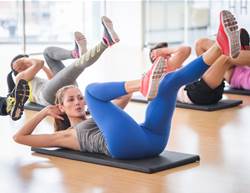You’ve probably heard of high-intensity interval training (HIIT), but what about high-impact training? Though they sound similar, these two workout styles focus on different aspects of fitness. Like HIIT, high-impact moves can support muscle and bone health—and the good news is, you may already be doing some without even realising.
We spoke to personal trainer Tina Tang and internist Dr Heather Fields, to get the lowdown on what high-impact training is, the benefits it brings, and how to ease into it safely.
What’s the difference between high intensity and high impact?
They might sound interchangeable, but they’re not. High-intensity training refers to how hard your cardiovascular system is working. “You’re usually training at 70 to 100% of your maximum heart rate,” explains Tang. “Think sprint intervals on a bike or rowing sprints—you’re puffing hard and can’t hold a conversation.” These workouts are often done in short bursts, with rest or lighter activity in between.
High-impact training, on the other hand, refers to physical impact—specifically, the mechanical loading that happens when your body hits the ground. That could mean jumping squats, bounding, or even a gentle jog. “It’s about the force going through your joints, bones and connective tissue,” says Tang.
“High-intensity training targets your heart, lungs and blood vessels, while high-impact training is designed to stimulate muscles and bones,” adds Dr Fields. You can combine the two—but you don’t have to. “You could do a high-intensity workout with no impact (like swimming), or a low-intensity session with impact (like light jump rope),” says Tang.
What are the benefits of high-impact exercise?
High-impact moves can do wonders for your muscles and bones. “Think of it as prevention for sarcopenia (muscle loss) and osteopenia or osteoporosis (bone thinning),” says Dr Fields. These exercises stimulate bone remodelling and help improve bone density—particularly important as we age and bone loss speeds up, especially after menopause, adds Tang.
One of Tang’s clients, a woman in her late 50s, noticed improved strength, better form, and more stamina in her regular workouts after completing two rounds of an eight-week plyometric program that included high-impact training.
Science backs that up. When you land during a jump, the mechanical loading sends a signal to your bones to reinforce themselves. “Our bodies are built to respond to the challenges we give them,” explains Tang. The result? A boost in bone strength called osteogenesis, especially in the hips, spine and legs—key areas vulnerable to osteoporotic fractures. Pair high-impact movement with strength training and you’ve got a powerful formula for protecting your bones.
There are mental benefits too. Tang’s client described how moving in new directions—like jumping backwards or sideways—pushed her coordination and balance in unfamiliar ways. “It was awkward at first,” she shared, “but I call them brain food. I could almost feel a part of my brain firing up.”
Is high impact exercise safe for women over 50?
Most likely yes—but it’s important to approach it with care. If you have osteoporosis or a history of fragility fractures, you’re at higher risk of injury and should check with your GP before starting something new. The same goes for anyone with cardiovascular concerns or pre-existing medical conditions. And if you experience chest pain while exercising, stop immediately and seek medical help.
Once you’ve been given the all-clear, start with strength training to build the foundation your joints and tissues need to absorb landing forces, says Tang. This helps your body prepare for the impact safely.
Ease into it. Even those with a solid fitness background often find high-impact moves like jumping rope challenging at first. But with consistency, strength and stamina improve.
Recovery is just as important as the workout itself. Avoid doing high-impact sessions on consecutive days, and be sure to include rest and active recovery. Your bones, muscles and connective tissue need time to adapt and grow stronger before you dial things up.
How can I safely integrate high impact exercise into my routine?
Your current fitness level matters—but it’s never too late to start. If you’re new to exercise or haven’t been active in a while, begin by building strength. Strength training lays the groundwork for safe and effective high-impact movement, especially during midlife and beyond.
Start with lower-impact activity and gradually increase how often, how long, and how hard you train. That might mean beginning with regular walks, then working up to hikes, stairs, or even rucking (walking with a weighted vest) in short bursts. Give your body time to adjust, and always listen to how it’s responding.
If possible, work with a qualified trainer or join a fitness class with an experienced instructor who can help you nail your form before adding intensity.
Once you’re ready, start small. Just two to three minutes of high-impact movement, a couple of times a week, is enough to start building tolerance. Think of it as a sprinkle, not a flood. You can include these movements at the start of a strength session, after warming up.
Some simple high-impact moves to try:
- Jump rope
- Lateral hops
- Jump squats
- Box jumps
- Running or short sprints
Where does low-impact exercise fit into all of this?
While high-impact has its perks, most of your weekly movement should still come from low-impact activity. These exercises support cardiovascular health, mobility and recovery without putting stress on your joints. A balanced routine blends both, with short bursts of high-impact or high-intensity movement layered in.
The bottom line
High-impact exercise can support bone density and muscle strength, but it’s just one part of the picture. Aim for at least 150 minutes of moderate-intensity aerobic activity each week, plus two to four strength sessions. Once you’ve got that foundation, a few minutes of high-impact movement can be a powerful addition—just be sure to check in with your GP if you have any health concerns first.










